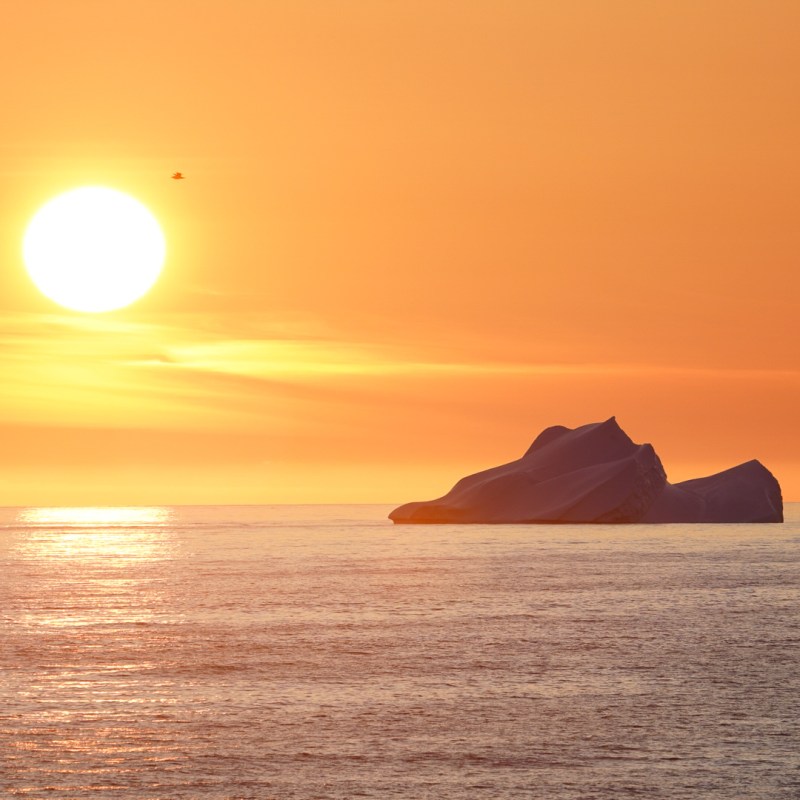
Stephanie Vermillion
The Arctic Circle is alluring in its remoteness; it’s one of the last few places on Earth that feels like a true adventure. That said, visiting the Arctic Circle also means you’re traversing some of the world’s most fragile ecosystems. Polar bears, whales, walruses, and a host of rare and endangered wildlife call these lands and waters home. Inuit communities across the north are also navigating recent tourism influxes, not to mention a changing climate.
Videos by TravelAwaits
The Arctic Circle is a bucket-list and awe-inspiring destination, but you shouldn’t just book a tour or hop on a plane and hope for the best. The Arctic and its inhabitants need travelers to research, take time, and plan their trips responsibly.
I was invited to experience northern Canada and Greenland with Adventure Canada, a small-ship expedition company that focuses on responsible travel, both culturally and environmentally. After touring with an expedition team of climate change scientists, geoscientists, archaeologists, culturalists, and explorers, I learned how to decrease my footprint on a trip to the fragile north. Here are seven takeaways to help you visit the Arctic Circle responsibly.

Stephanie Vermillion
1. Choose A Responsible Tour Company
The Arctic Circle is not like, say, Europe. You can’t just show up with a backpack and figure it out. In most cases, it’s best to travel with a tourism company to ensure you’re safely visiting these wildlife-rich destinations (for the wildlife and yourself). By choosing a responsible tourism company, you’re taking a big first step toward responsible Arctic tourism.
Companies like Adventure Canada, which runs small-boat Arctic expeditions like the one I joined, make it easy to select a sustainable Arctic travel opportunity. Just look on the tour operator’s website or social media for clues. For instance, Adventure Canada empowers local communities by hiring Inuit guides at all levels — including as expedition leader — so guests learn from the people who actually live there. They also support the not-for-profit program Students on Ice, which fosters education among young and diverse conservationists. If your tour company can check at least a few of these boxes, you can head into your trip knowing you made a smart and safe-for-the-environment choice.

Stephanie Vermillion
2. Opt For Smaller Ships
As its narrow, ice-filled passageways indicate, the Arctic was not built for massive cruise ships. Adventure Canada ships typically host 200 passengers or less, which means a lower impact in terms of tourist numbers and a smaller, less intrusive ship.
Speaking of small boats, another way people travel through the Arctic’s Northwest Passage is by sailing, but this requires massive research on logistics, permits, and hiring the right crew. (For a glimpse into this type of travel, watch the 2015 documentary The Polar Sea.)

Stephanie Vermillion
3. Learn About The Culture
Before even stepping foot on Arctic soil, spend time learning about the Inuit culture. This is an entirely different culture than most people are used to, but it’s not “foreign” or “exotic.” It’s just, well, different. By learning about Inuit history — including troubling treatment in Canada — you’ll go into the trip with an appreciation for just how strong willed the people welcoming you really are.
By learning about contemporary Inuit culture, you’ll be able to relate better once you step foot on their soil. Circling the Midnight Sun is a great book that highlights the changing Inuit culture. Its author and longtime explorer, James Raffan, was actually part of the Adventure Canada expedition crew during my High Arctic trip, too.

Stephanie Vermillion
4. Enjoy Wildlife, From A Distance
Wildlife is one of the biggest High Arctic draws. You have the chance to see narwhals, polar bears, humpback whales, seals, walruses, and so many other unique and awe-inspiring animals. But these wild animals should remain, well, wild. That means enjoying the Arctic wildlife must happen at a safe distance. On foot, you should never approach a wild animal for a whole host of safety reasons. But even if you’re on a boat or bike ride, don’t let the excitement of capturing a good photo put a vulnerable animal at risk.
In many cases, it’s not up to you how close your tour guides get to an animal. With an eco-friendly company like Adventure Canada, guides are required to stay a ways back, unless the animal approaches the ship or zodiac boats on its own. Sure, the captain will idle and let the ship slowly move in the direction of, say, a polar bear on land, but when we saw swimming animals or vulnerable wildlife on the shores, we stopped, looked through binoculars, then moved on.
If you’re on a one-off tour with a company, let them know from the get-go that you’d rather stay at a safe and respectful distance if you spot whales or bears. This will set the tone for a responsible wildlife-viewing trip and will take the pressure off your guides, who are inevitably working for a tip.

Stephanie Vermillion
5. Don’t Photograph People Without Permission
When you’re visiting a new place like the Arctic, it’s tempting to pull out your camera the second you land in a new community. Of course, you can take photos of these beautiful towns and the warm, welcoming people — but only if you ask. A good rule of thumb for travel photography is, If you wouldn’t do it at home, don’t do it here. I try to start a conversation first so that I can make a genuine, albeit brief, memory with the person; the photograph will then help me remember this once-in-a-lifetime connection.

Stephanie Vermillion
6. Buy Local Souvenirs
As climate change impacts lifestyles across the Arctic, many Inuit are turning to tourism as a way to make ends meet. That’s why buying your souvenirs straight from the source — on the ground in local Arctic communities — is incredibly important. This approach guarantees your money goes to the artist or maker, which also means you could have the chance to meet the person behind your souvenir!
If you’re unsure about whether you’re buying from a locally sourced shop or not, ask the store owner where they get their merchandise. Or, if you’re on an expedition with Inuit guides, ask them for tips on where to shop.

Stephanie Vermillion
7. Spread Your Knowledge At Home
Visiting the Arctic Circle is a rare privilege. This trip-of-a-lifetime will put you face to face with the reality of climate change. Iceberg views will leave you awestruck, as will the diverse wildlife that flocks to the them. Interacting with Inuit people will help you put a face to climate problems, as they’ve been among the first to suffer — and are the least to blame.
A trip to the Arctic Circle is only responsible if you go home and spread your knowledge about what you saw in the Arctic Circle — and not just the beauty or the narwhal sighting. According to Cedar Swan, CEO of Adventure Canada, giving voices to vast environmental problems is one of the best ways her company can make a difference.
“I think our opportunity is to come home and be ambassadors for this place, because this experience shapes us and makes us just a little bit different,” she said. “Our hope is that we all go home as advocates, as allies, and with connections meaningful enough that we’ll fight for it.”

Stephanie Vermillion
A Few Things To Know Before Visiting The Arctic
Now that you’re ready to visit the Arctic responsibly, here are a few things to keep in mind before you jetset up north.
The Arctic Circle spans over 9,000 miles. Some of the easiest places to visit include northern Canada, Alaska, and northern Greenland. Your guide will likely choose your route for you, but if you know you want to visit say, Greenland, choose a company that specializes in this portion of the Arctic.
It’s crazy sunny! Sure, it’s chilly — and downright freezing (or below) — most of the year, but in the summer, the sun radiates off the icebergs and water. Bring sunscreen and some good sunblock on your spring, summer, or fall Arctic trip. That said, if you’re visiting in the winter, you won’t have to worry about sunscreen because there’s no sunlight!
Cold weather kills camera batteries, so make sure you pack a spare battery for any device you bring. Take it from the girl whose camera battery almost died when the first whale was spotted!
If you’d rather work your way up to the Arctic, Iceland may be a good place to test the waters — literally. Here’s how to visit the Blue Lagoon in Iceland as part of a trip north.


